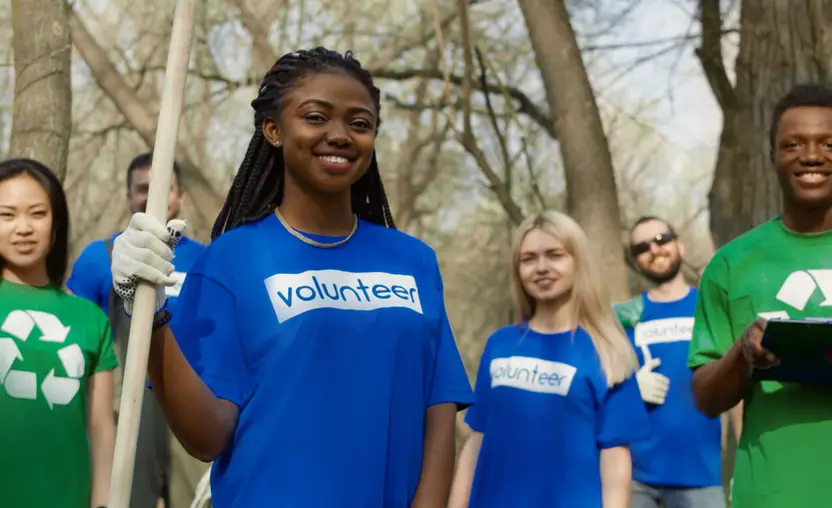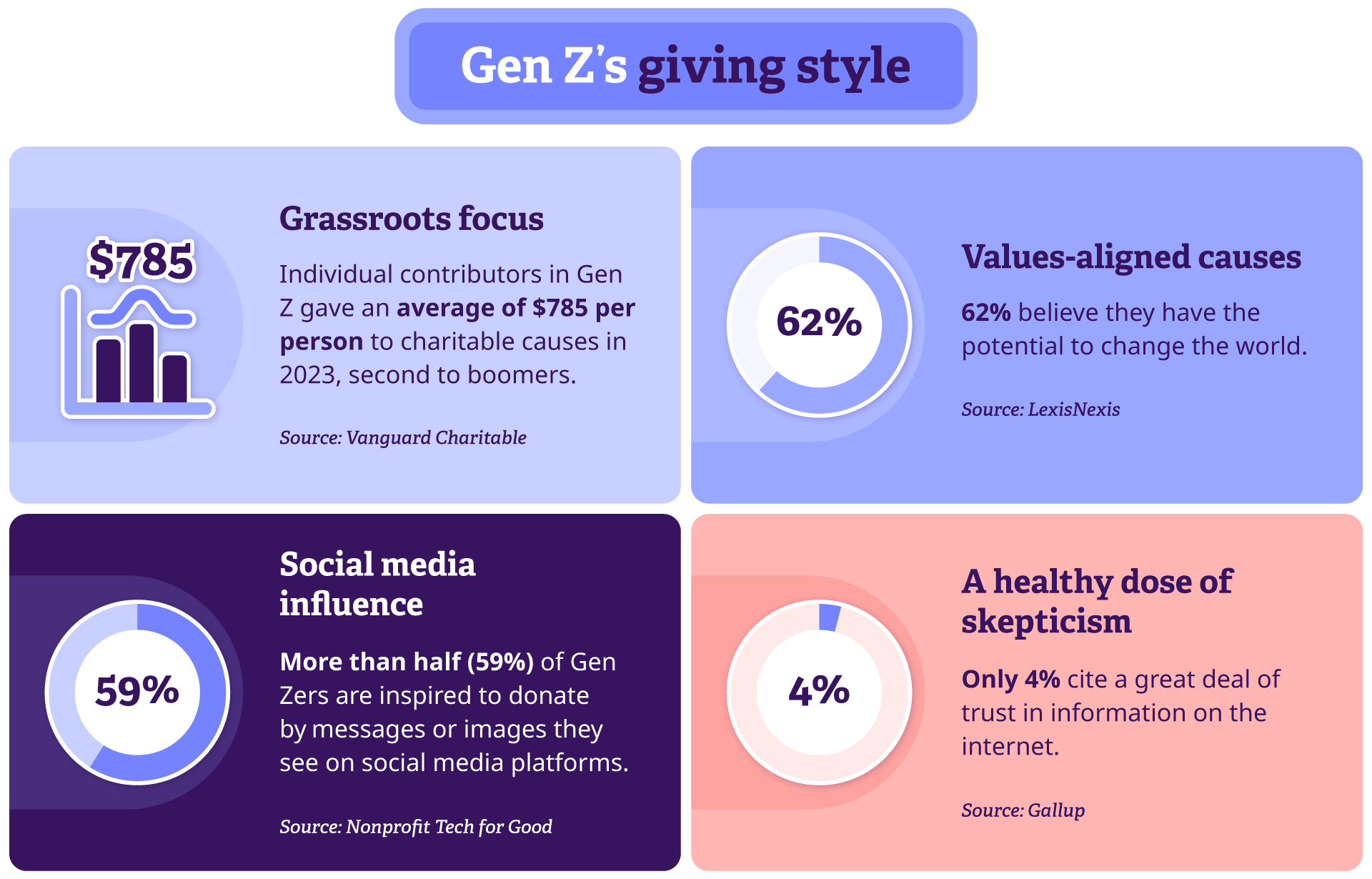What nonprofits need to get right about Gen Z

In Philadelphia, a college student scrolling social media comes across a post about a local clean water initiative in between their usual feed of cat videos and book reviews. With just a few taps, they’ve made a small donation and shared the campaign with their network. Across the country, in San Francisco, a teenager livestreams her 24-hour gaming marathon to raise funds for mental health awareness. And in a small Midwestern town, a high school senior organizes a social media campaign to support a local food bank, garnering thousands of small donations from peers across the country.
These scenes, increasingly common among members of Generation Z, represent a seismic shift in the world of philanthropy. Defined as people born between 1997 and 2012, Gen Z isn’t just changing fashion trends or redefining workplace norms: They’re revolutionizing how we think about giving, volunteering, and social impact.
Kimberly O’Donnell is Bonterra’s chief fundraising officer. She says that Gen Z is unique in the way they engage with social good. “There are some traits about Gen Z, or “PhilanthroKids” and “PhilanthroTeens” as they have been called, that make engagement obvious—digital drives their lives. This generation wants to make the world a better place and they understand the ripple effect of small acts, and how to dive deep quickly to research the things and causes they care about.”
“This generation wants to make the world a better place and they understand the ripple effect of small acts, and how to dive deep quickly to research the things and causes they care about.”
Kimberly O’Donnell, Chief Fundraising Officer, Bonterra
These digital natives aren’t shy to engage with the causes they care about, including issues like climate action, racial justice, gender equity, and mental health awareness. They also tend to pursue values-based work and hobbies. As this generation begins entering the workforce in droves, they’re giving us early glimpses of their working styles, career aspirations, and spending habits. Economists are watching this early data with a hawkeye, as Gen Z is poised to represent about 30% of the global workforce by 2030.
While Gen Z is not a monolith by any means — the individuals that make up this cohort have distinct personalities, backgrounds, and experiences — they share some commonalities that might impact how they’ll wield their mounting economic power. As such, nonprofits and charitable organizations simply can’t afford to ignore this group’s growing influence.

Gen Z and the evolving digital philanthropy landscape
Gen Z’s approach to giving is also shaped in part by their relationship with technology. For every Baby Boomer more comfortable writing a check, there’s a Gen Zer setting up a recurring donation via mobile app. As the first generation of true digital natives to come of age, they’re comfortable using a wide range of donation methods — from traditional cash to social media fundraisers and crowdfunding platforms, to even more innovative options like cryptocurrencies.
This generation is also drawn to interactive and gamified approaches to philanthropy. For example, they might participate in charity livestreams or use apps that round up purchases to donate the difference. Or they may appreciate virtual volunteering opportunities that allow them to contribute their skills remotely to causes around the globe.
But technology and connectivity aren’t always a boon: The sheer number of organizations vying for attention — especially on social media — can lead to information overload or decision paralysis, making it challenging for Gen Zers to decide where to direct their support.
Dr. Frank Raymond, an associate professor of economics at Bellarmine University, says Gen Zers need a sense of connection to an organization or cause to feel compelled to donate. “With [Gen Z and millennials], there’s skepticism, and for good reason,” he says. “They’re bombarded with texts, calls, and emails asking for money and aren’t sure where to give. For them, it’s about building relationships. They want a return on their investment. And that return from giving is what’s known as a ‘warm glow’— knowing their contributions are going toward good.”
Bridging the gap: strategies for nonprofits
Kimberly cites a few key ways to engage with Gen Z that differ from traditional approaches to other generations. To court Gen Z donations, nonprofits need to:
- Build trust and transparency: According to Kimberly, fundraising engagement with Gen Z requires clear and honest communication about how donations are used. “With this generation, communication needs to be succinct, digestible, and actionable.” Data can be helpful here: Nearly 70% of Gen Zers say impact reporting helps motivate them to give.
- Adapt to preferred platforms: It’s imperative to meet Gen Z where they are — on social media, mobile devices, and in emerging digital spaces. Says Kimberly, “Fundraisers sometimes struggle with engaging Gen Z because they are not as tech-savvy themselves and are hesitant to jump into gaming, influencer marketing, and emerging social platforms. Those that do are building solid networks for the future — both in awareness and dollars.”
- Embrace technology: Kimberly says that novel approaches to engagement appeal to Gen Z, so her advice is to not shy away from integrating new technologies into philanthropic efforts or donation collection processes. “Strategic fundraisers know that meeting these digital natives where they are will pay off in the long run. Gaming and influencer fundraising use peer-to-peer tactics with the added benefit of immediate interaction, authenticity, and gratification. Video and text are two easy ways to connect, as is having mobile-friendly websites and donation pages.”
Rethinking the future of giving
Even for organizations that haven’t historically had a tech-forward approach to operations, it’s not too late to adapt and modernize. Optimally, digital natives will thrive in an environment where smart tech is utilized to create greater impact. Technology partners like Bonterra can provide tools and platforms designed to help navigate the changing landscape of charitable giving and create experiences that cater to every generation of donor.
In the United States, charitable giving has plateaued over the past several decades — it’s remained stagnant at around 2.5% of the U.S. Gross Domestic Product (GDP) for more than 50 years. Gen Z just might provide the leverage needed to get us out of this rut. As their earning power grows, they have the potential to play a crucial role in reaching Bonterra’s goal of increasing charitable giving to 3% of US GDP by 2033.
For nonprofits willing to embrace this new era of giving — to meet Gen Z where they are, and with the technologies they use — the possibilities for positive impact are truly limitless. The future of philanthropy is being written right now, one micro-donation, livestream, and purchase round-up at a time.
Work with Bonterra



